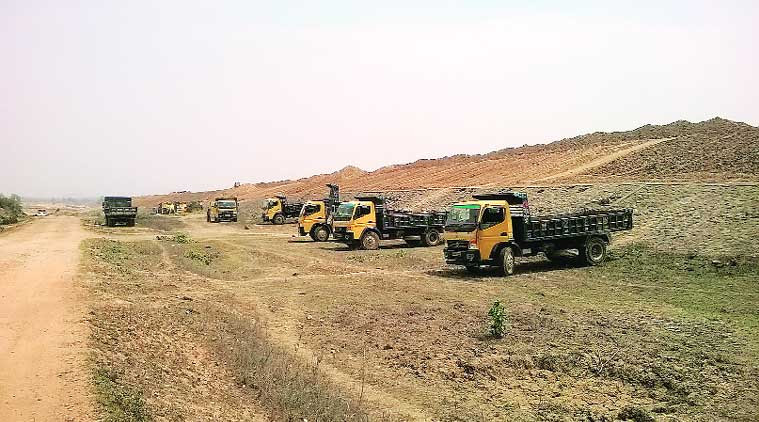Kanhar Irrigation Project was dormant for nearly 40 years before Uttar Pradesh govt set about reviving it. This has led to violent protests by villagers it will displace, police firing and opposition from two states. From Sonbhadra in UP and Jhara in Chhattisgarh, Maulshree Seth reports.
Akloo Parhiya was 10 years old in 1976 when N D Tiwari, Uttar Pradesh’s then CM, laid the foundation stone for the Kanhar Irrigation Project at the junction of three states. Last month, Parhiya was injured while leading a violent protest against displacement by the same project, work on which has suddenly picked up after nearly four decades of stagnancy.
“It is difficult to trust a government that betrayed our forefathers four decades ago and now wants us to move to a 150 sq m plot with a Rs 2 lakh cheque (the first instalment of relief),” says the tribal leader, now 48.
A villager of Sundari in UP, he is now in Chhattisgarh’s Jhara village, his wife’s home, following his treatment for injury, paid for by the UP government. Both villages will be among those inundated by the project, which is on the border of three Naxal-hit districts, Sonbhadra (UP), Balrampur (Chhattisgarh) and Garhwa (Jharkhand). Water from its dams will submerge 4,077 hectares, much of it forest land, and villagers are demanding alternative forest land rather than the plot allotted by the UP government.
The protests have ceased for now for fear of police action. They had been peaceful until the violence of April 14 leading to police firing. The agitation had begun last December following efforts to revive the dormant project.
 Akloo Parhiya, who was injured during the protest that led to police firing.
Akloo Parhiya, who was injured during the protest that led to police firing.
Then and now
UP acquired the land on the site from 1979 to 1984 at a compensation of Rs 1,800 to Rs 4,500 per acre. The rehabilitation promised was plots 50 ft by 30 but the state didn’t take possession of the acquired land then. It spent most of the subsequent years chasing the consent of its neighbouring states, then undivided Madhya Pradesh and Bihar. Although MP consented in 1999, the affected areas went to Chhattisgarh the following year. Jharkhand consented in 2002 and Chhattisgarh in 2010 but both have now objected to the start of construction without fixing a rehabilitation package (see report).

Mayawati’s government tried to start work in 2011 but shelved it following protests from tribals. For the current government, the project came on a platter with all approvals in, including from National Green Tribunal.
Inevitably, however, much has changed in four decades. The project cost has multiplied from Rs 27.75 crore as estimated in 1979 to Rs 2,257 crore now, and the rehabilitation amount from Rs 1.07 crore to Rs 150 crore. The number of displaced families has risen from 1,044 (385 family heads have died and 284 are untraceable) to 1,810 now. This is according to an estimate last year.
The government cannot offer compensation a second time for land already acquired, hence it has described the package as one of relief and rehabilitation, decided last October, and comprising Rs 7.10 lakh and a plot of 150 square metres.
The government claims it is the first time in the country that relief is being offered to three generations of the original families. Each day, a vehicle carrying Dudhi subdivisional magistrate G S Singh or other staff has been visiting villagers in the forest to convince them to move to the colony being developed for them in Amvar village. So far, however, only 550 of the 1,810 families identified have accepted.
Even the number of 1,810 in Sonbhadra has been the subject of controversy. Villagers have alleged there were mistakes in the original identification and the government is undertaking a fresh survey.
“There is no tension in the area. Negotiations are on,” says SDM Singh. “About 550 families have accepted relief; the rest are going to accept soon. Construction of the colony with a school, water supply and hospital is under way.”
Fears both sides
At Sundari village, a few kilometers from the site, locals have no issue to discuss other than the dam. “We are not protesting out of fear but we are not accepting either. We are tribals and so should be given forest land rather than a 150 sq m plot with drainage and streetlights,” says Chandrani Kharwar, who is heading negotiations between the village’s farmers and the government. “Out of Rs 7.11 lakh promised, the government is giving only a Rs 2 lakh cheque. Also, Rs 75,000 of this is to build a house on the plot. How are we supposed to earn our living?”
“We also want the government to give in writing that we will be given back our land if the project does not start in the next five years,” says a neighbour, “because otherwise our grandchildren will one day be stripped of their livelihood in a similar manner.”
At the dam site, officials say submergence is not an immediate concern. “It will take three years before these villages are submerged. No one knows how things would turn out then,” says one of them.
The government is wary. A wire fences the project site to prevent villagers from barging in. A PAC platoon stands near temporary rooms constructed for the staff.
Vijay Kumar, executive engineer for the construction, says, “About 4,000 hectares will submerge, displacing about 2,500 families, but the project will also bring livelihood, irrigation and clean drinking water to over 108 villages spread over 35,000 hectares in Sonbhadra. It will boost the economy of this Naxal-hit underdeveloped region.”




No comments:
Post a Comment